A History of the County of Hampshire: Volume 4. Originally published by Victoria County History, London, 1911.
This free content was digitised by double rekeying. All rights reserved.
'Parishes: Amport', in A History of the County of Hampshire: Volume 4, ed. William Page (London, 1911), British History Online https://prod.british-history.ac.uk/vch/hants/vol4/pp337-344 [accessed 23 April 2025].
'Parishes: Amport', in A History of the County of Hampshire: Volume 4. Edited by William Page (London, 1911), British History Online, accessed April 23, 2025, https://prod.british-history.ac.uk/vch/hants/vol4/pp337-344.
"Parishes: Amport". A History of the County of Hampshire: Volume 4. Ed. William Page (London, 1911), British History Online. Web. 23 April 2025. https://prod.british-history.ac.uk/vch/hants/vol4/pp337-344.
In this section
AMPORT
Anne (xi cent.); Anne de Port (xiii cent.); Andeporte (xiv cent.); Anneport (xv cent.).
Amport is an irregularly-shaped parish, one of the largest in the hundred, containing 3,962 acres, of which 2,408 acres are arable land, 753 acres permanent grass and 522 acres woods and plantations. (fn. 1) The soil is very light and the subsoil chalk. (fn. 2) The chief crops are wheat, barley, oats, sainfoin and turnips. The average height above sea level is rather over 300 ft. Towards the west, however, the ground rises considerably, reaching 544 ft., its highest point, on Cholderton Hill. In the southern part of the parish there are considerable stretches of woodland, the principal being Sarson Wood, Upper and Lower Amport Woods, Gollard Copse, Great and Little Vinels Copses and Hurst Copse. In Gollard Copse and Gollard Farm, hard by, is no doubt preserved the name of the tenement, La Goldhorde, which the priory of Ogbourne once owned here (vide infra).
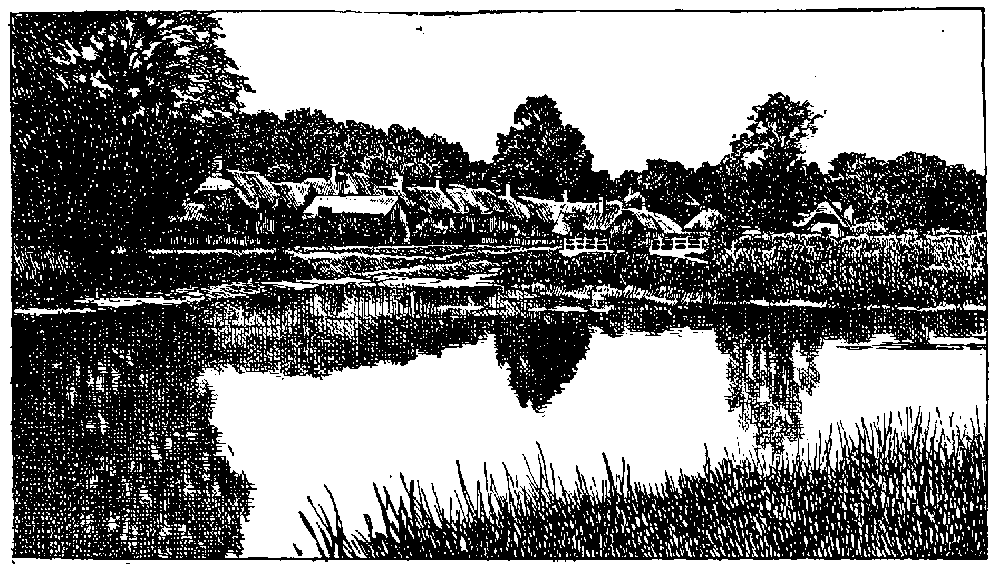
Amport: The Village
Amport House, a seat of the Marquess of Winchester, built half a century ago in the Elizabethan style, stands in a park of 200 acres. The village lies to the north of the park, with the church at its west end, A little to the east, adjoining Monxton, is Sarson, while East Cholderton lies northward on the road to Thruxton. Northward again is Dancy, a hamlet included in the tithing of Sarson but partly in Appleshaw. Middlecot tithing is 3 miles west of Amport, while Cholderton Lodge is on the Wiltshire border, a mile further on. It is a building of red brick and flint standing in wooded grounds of 60 acres, and is at present occupied by Mr. Henry Charles Stephens, J.P. It was formerly the seat of Rev. W. Knatchbull.
The road from Andover to Amesbury follows the northern border of the parish and the site of the Port Way, to which a modern road keeps more or less closely, passes through Amport Park.
Manors
The manor of AMPORT, called simply Anne in Domesday Book, was held before the Conquest by Edric. In 1086 it was held by Hugh de Port (fn. 3) and formed part of the barony of Basing (q.v.). In 1241, for 6 silver marks, Robert St. John, the overlord, the descendant of Hugh de Port, quitclaimed to the mesne lord Thomas de Port and his heirs the suit which they owed every three weeks at his court of Basing. (fn. 4) The overlordship of Amport followed the descent of the barony, (fn. 5) passing in 1349 to Luke de Poynings and Isabel his wife on the apportionment of the possessions of Hugh St. John among his sisters and co-heirs, (fn. 6) and to Sir John Paulet in 1429 on the death of Thomas Poynings, Lord St. John, whose granddaughter and co-heir he had married. It is interesting to note that the direct descendant of these early overlords now holds the manor.
The earliest mesne lords of Amport were presumably a younger branch of the Port family, holding from the head of their house. It was from them that the manor derived its distinctive name of Ann de Port or Amport. In 1228 John de Port claimed an assize of novel disseisin against Henry de Brayboef, Laurence de Cundy, Thomas de Cirencester and Thomas de Port of his tenement in Ann (fn. 7); but in Easter term of the following year judgement was given against the plantiff in the King's Bench. The record of this suit shows that John and Thomas de Port were the sons of Thomas de Port, who had been mesne lord of a knight's fee in Anne, and that they had an elder brother Philip; further, that Thomas the younger did not hold the whole fee, as he had neither the advowson of the church with a carucate and 4 acres of land appurtenant nor a carucate called 'Golhord' (fn. 8) which the Prior of Ogbourne held. (fn. 9) In 1236 Philip de Port, evidently the elder brother just mentioned, quitclaimed this fee to Thomas and his heirs. (fn. 10) It was doubtless this same Thomas who is entered in Testa de Nevill as holding Amport as one knight's fee of the old feoffment of Robert St. John, the tenant in chief, (fn. 11) and to whom in 1241 Robert St. John gave quittance of making suit at Basing. (fn. 12) Thomas de Port mortgaged land of the value of £10, which seems to represent the manor, to Beletoun the Jew, who in 1263 demised it to William de Apelderford. (fn. 13) William was doubtless succeeded by that Stephen de Apelderford who is mentioned in the 'Aid' of 1346 as having formerly held 2 hides in Amport. (fn. 14) For some reason, however, the manor had escheated to the overlords before 1306. In that year John St. John, the first of the name to be summoned to Parliament, assigned his right therein to Thomas de Quarley, clerk, and John de St. Manifeo, (fn. 15) who consequently appear as lords of the vill in the Nomina Villarum ten years later. (fn. 16)
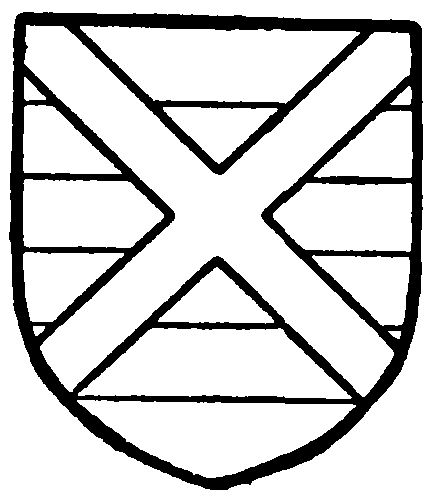
Port. Barry azure and argent a saltire gules
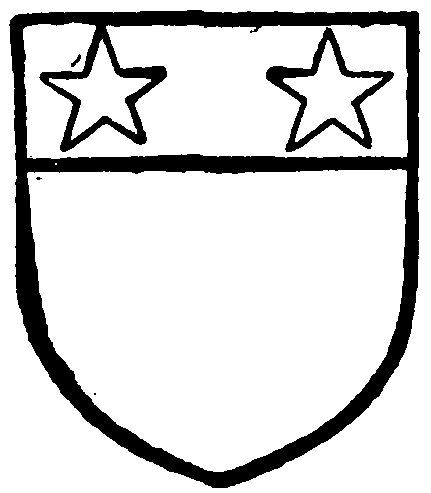
St. John. Argent a chief gules with two molets or therein.

Poynings. Barry or and vert a baston gules.
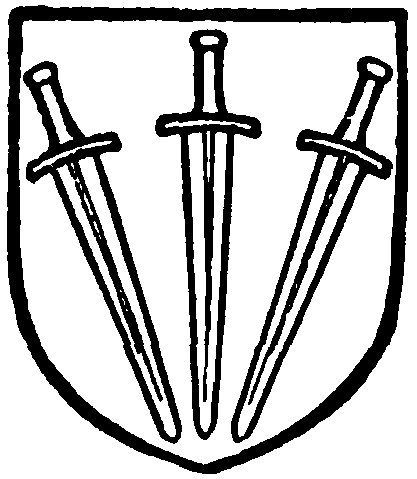
Paulet. Sable three swords argent set pilewise with their hilts or.
The manor was still in the hands of these tenants in 1325 when they fined with John Roger of Tidworth and Thomas de St. Manifeo for the purpose of entailing it on John de St. Manifeo and his heirs, with remainders to his brother Thomas, his sister Alice, and Maud daughter of Hugh Angot of Quarley and their heirs. (fn. 17) Shortly after this, at least by 1342 (vide infra), the manor passed into the hands of the Carews of Mohun's Ottery (co. Devon). Joan Carew was returned as the holder in 1346. (fn. 18)
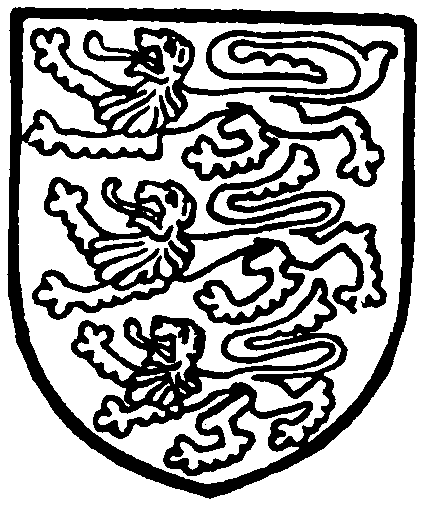
Carew. Or three lions passant sable.
There was a Joan Carew living at this date, viz. Joan Talbot, the second wife of John Carew, who died in 1324. (fn. 19) But the probability is that 'Johanna' is a mistake for ' Johannes,' for John Carew, the son of John Carew and Joan his wife, was in possession of the manor in 1342, (fn. 20) and was returned as holding the St. John fee of Amport in 1349. (fn. 21) He died seised in 1362. (fn. 22) Subsequently an inquiry was made as to whether dower therein had been correctly assigned to Elizabeth, his widow, seeing that Leonard, his son and heir, said that the manor had been granted by feoffees to John and Margaret, his first wife, whose son the said Leonard was. The jury found that the alleged enfeoffment had been made in 1342. (fn. 23)
Leonard Carew died in 1369, having conveyed the manor to feoffees before going abroad in the train of the Earl of Pembroke, (fn. 24) presumably in the same year, when the earl went to France for the first time. In 1431 his son Sir Thomas Carew died seised jointly with his wife Elizabeth, (fn. 25) who in the'Aid' of the same year figures as Elizabeth Carew of 'Mones Otrey (Mohun's Ottery, in Luppit, co. Devon), gentilwoman,' holding one quarter of a knight's fee in Amport. (fn. 26) In 1437 this and other manors were settled on her for life, with remainder to her son Nicholas Carew and Joan his wife. (fn. 27) Amport continued to be held by the Carew family until 1497, (fn. 28) when Sir Edmund Carew, great-grandson of Nicholas, sold it to Bartholomew Reed, citizen and goldsmith of London, (fn. 29) who died seised thereof in 1505, having by his will settled his new property on his wife Elizabeth for life, with an estate of ten years after her death to the Goldsmiths' Company, and remainder to his nephew William, younger son of his brother John Reed, and his male issue. (fn. 30) In 1572 another Bartholomew Reed sold the manor to Alexander Irton, (fn. 31) a cadet of the Cumberland house of Irton of Irton. At the Wiltshire visitation of 1623 was registered the pedigree of George Irton of Britford and Amport son of Alexander Irton of Amport, (fn. 32) and the family also appears in the Hampshire visitation of 1634. (fn. 33) George Irton had a son Richard, aged twentythree in 1623, and a daughter Joan, wife of Thomas Goldston of Alderbury (co. Wilts.). (fn. 34) At the Wiltshire visitation the pedigree of Goldston was also recorded, which shows Thomas Goldston and Joan Irton to have had a son and heir Richard, then aged two months. (fn. 35) This Richard may perhaps be identified with the Richard Goldston of Amport who was compounding for delinquency in 1649. (fn. 36) His fine—assessed at one-sixth of his estate—amounted to £150. Shortly after this the manor became the property of the house that still owns it. Lord Henry Paulet, fourth son of William fourth Marquess of Winchester and a younger brother of the 'loyal marquess,' was lord of Amport in the reign of Charles II. He died in 1672, (fn. 37) and was succeeded by his son Francis, and his grandson Norton Paulet. (fn. 38) On the death in 1794 of Harry sixth and last Duke of Bolton and eleventh Marquess of Winchester George eighth and youngest son of Norton Paulet of Amport succeeded to the marquessate, (fn. 39) and from him is descended Henry William Montagu (Paulet) sixteenth Marquess of Winchester, now lord of the manor of Amport, where is his chief seat.
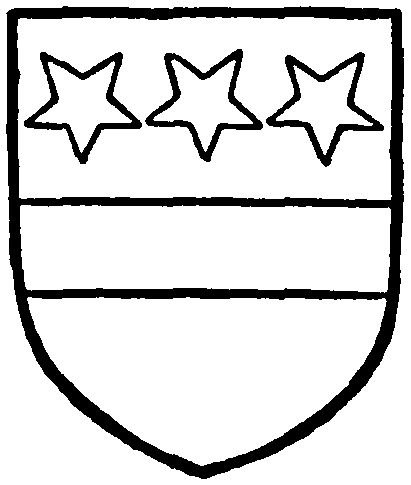
Irton. Argent a fesse sable with three molets gules in the chief.
There was a mill at Amport in 1086 worth 20s. (fn. 40) In 1328 Thomas de Quarley and John de St. Manifeo, the lords of the manor, granted to John de Cormeilles, lord of Thruxton, and his heirs the water flowing from the mill-wheel in Amport as far as the way which lay on the west of the wheel by the said vill with the right of digging and dredging (fodere et mundare), and making a fish-stew, in return for which John de Cormeilles granted them and their tenants the right of pasturing their cattle on the grass which grew in the water and gathering the said grass for the strawing of their houses. (fn. 41) A water-mill is mentioned in an extent of the manor in 1451. (fn. 42) Sir George Philpot, lord of Thruxton, who died in 1624, (fn. 43) and his son Sir John were both seised of a water-mill in Amport, (fn. 44) and in the deed of sale of Thruxton Manor to George Paulet (1783) there is mention of a close of meadow called Millhamby in Amport, near the old mill there. (fn. 45)

Marshal. Party or and vert a lion gules.
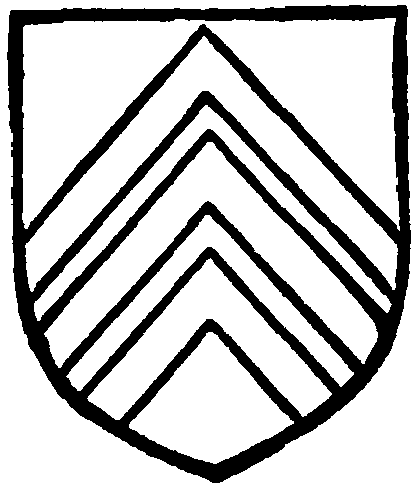
Clare. Or three cheverons gules.
There are four entries of CHOLDERTON (Cerewartone, xi cent.; Chelewarton, Schilwareton, Chulewirton, xiii cent.) in Domesday Book. Gilbert de Breteville held 4 hides and 3 virgates of the king, of which one Ralf was his under-tenant. This had formerly been held as an alod by four freemen as four manors. (fn. 46) Either this or the holding of William son of Baderon, consisting of 1 hide and 2½ virgates, which had been held as an alod of the Confessor by three freemen, is to be identified with the later manor. (fn. 47) The history of the overlordship of the manor is not clear, but it seems probable that the knight's fee which Henry de Columbers held in 1208 (fn. 48) and Thomas de Cholderton held later in the 13th century of Matthew de Columbers (fn. 49) was held by the Columbers of the Marshals of England (fn. 50) and was represented by the half-fee held in 1280 by Matthew de Columbers of the Earl of Gloucester of the heirs of the Marshal. (fn. 51) Moreover Roger Bigod Earl of Norfolk and Marshal of England was overlord of Cholderton at his death in 1306 (fn. 52) (when the office became vested in the Crown), (fn. 53) and Roger Norman was holding of John de Cobham the Marshal half a century later. (fn. 54) However, there was another three-quarters of a fee in Cholderton held by Thomas de Cholderton of the Earl of Hereford, as Mr. Round has discovered, at the time of the Testa de Nevili, (fn. 55) but this overlordship apparently merged in the other at a later date.
Henry de Ann appears to have been lord of the manor, holding of Henry de Columbers, in 1200. (fn. 56) Within the next few years he acquired a hide of land in Cholderton from Richard Murdac and another from Henry de Stratfield, (fn. 57) the first of which probably, and the second possibly, represented the Domesday estate of 2 hides and ¼ virgate which Robert son of Murdac held in chief. (fn. 58) The lords of Cholderton throughout the 13 th century are sometimes spoken of as 'de Ann,' sometimes as ' de Cholderton,' but these designations seem to refer to the same family. In the middle of the century Thomas de Cholderton was holding of Matthew de Columbers and the Earl of Hereford. (fn. 59) In 1278 a moiety of the lands of Thomas de Cholderton in Cholderton and in Ann Savage was assigned to Benedict, a Jew of Winchester, to whom he was indebted, (fn. 60) and two years later, the Jew having been hanged for felony, the premises, together with the debts and arrears of Thomas, were given to Hugh son of Otto in compensation for the custody of the dies of London and Canterbury. (fn. 61) In 1287 John Maude sought to replevy to Thomas de Cholderton his lands in Cholderton and Appleshaw, which had been taken into the king's hands for his default against Roger de Leckford and Emma his wife. (fn. 62) This Thomas is to be identified with the Thomas de Ann who was at this date holding in Ann Savage of the honour of Wigmore. (fn. 63) John de Ann held three-quarters of a fee of the Marshal of England in 1306, (fn. 64) and ten years later the vill was found to be divided between John de Ann, Philip de Ann, Philip Wasprai and John de Romsey. (fn. 65) In 1321 Philip son of John de Ann conveyed to Ingram Berenger two messuages, land and rent in Cholderton, which William de Shuldeleye held for life. (fn. 66) This appears to have ended the de Ann connexion with Cholderton, and in 1329 Sir Ingram Berenger conveyed a messuage and land there to Roger Norman and Joan his wife. (fn. 67) In 1337 Norman was granted free warren in Cholderton, (fn. 68) and in 1346 he appears as holding there a quarter of a fee, which had formerly belonged to Philip de Sancto Austolo and other coparceners. (fn. 69) Except here and in the 'Aid' of 1428 there is no mention of this Philip de Sancto Austolo. A possible solution is to identify him with Philip de Ann. Roger Norman died seised of the manor of Cholderton in 1349, (fn. 70) leaving a grandson and heir Giles, during whose minority it was in the custody of Peter de Bridges at a rent of £23 6s. 8d. (fn. 71) On the death of Giles in 1363 Richard Cavendish and Julia his wife, John de Glemsford and Beatrice his wire, and William Chamberlayne and Christine his wife granted the manor (fn. 72) to the same Peter de Bridges. (fn. 73) It is possible that the three ladies named in this deed were co-heirs to Roger Norman's estates as daughters of Margaret wife of John Chamberlayne and heir of her cousin Giles Norman. However that may be, in 1391 Richard Becket and Alice his wife, kinswoman and heir of Roger Norman, obtained an inspeximus and confirmation of a charter of free warren which had been granted to Roger Norman, (fn. 74) and Alice Becket was daughter and heir of Richard Cavendish. (fn. 75) Richard Becket, who died lord of the manor of South Tidworth in 1411, was not then seised of Cholderton. The latter had probably passed by sale from Peter de Bridges to Sir Walter Sandys, who in 1428 held the quarter fee which had belonged to Philip de Sancto Austolo. (fn. 76) His son Thomas Sandys died seised of the manor in 1442, (fn. 77) and it descended to the Lords Sandys of the Vyne, (fn. 78) who were holding at the end of the 16th century. No later record of the existence of a manor in Cholderton has been discovered, but in 1742 the site is mentioned in a recovery of the manor of Amport, (fn. 79) to which it had doubtless become attached.
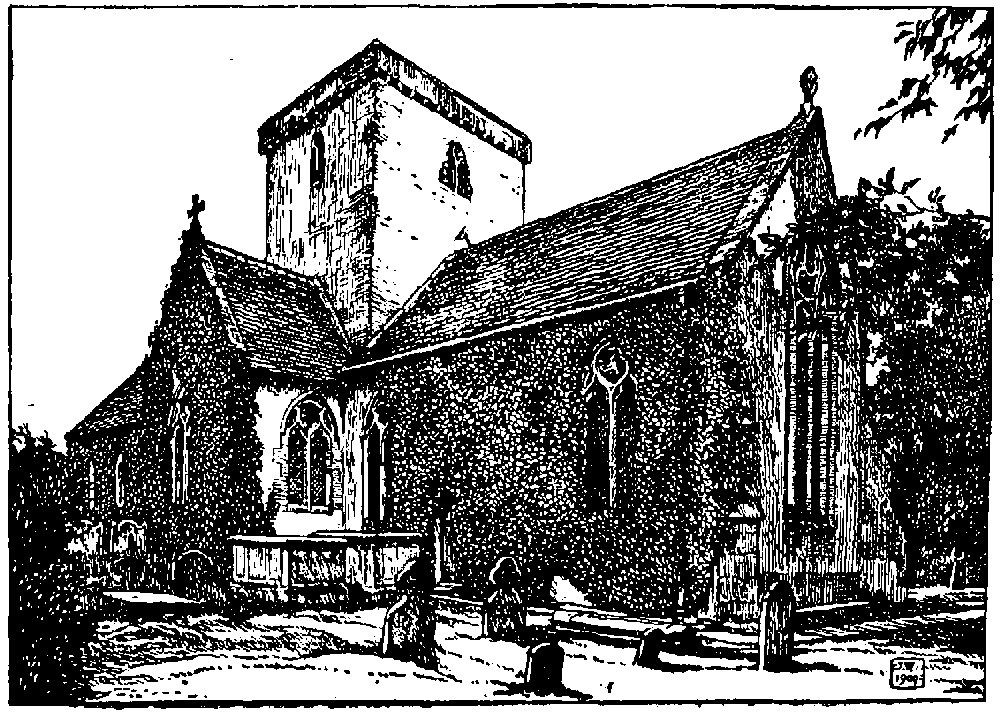
Amport Church from the South-east
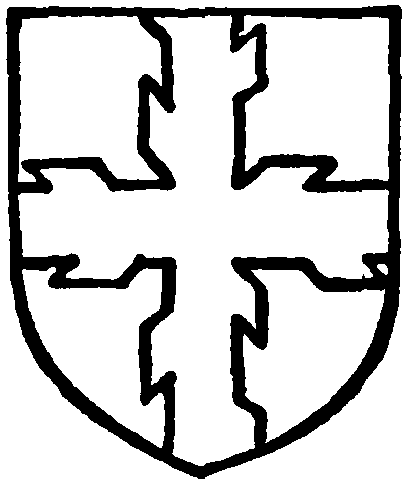
Sandys. Argent a ragged cross sable.
John Leland in his Itinerary thus refers to Cholderton:—'The auncient house, as far as I can lerne, that the Sannes hath possessed is Choldretoun, a mile and a half from Andover in Hamptonshire, where yet remainith a fair manor place buildid for the most part of flint.' (fn. 80)
A mill is mentioned in a fine of a hide of land in Cholderton in 1205, (fn. 81) and is probably the water-mill which is noted in an extent of the manor made in 1349. (fn. 82)
At Domesday Hugh de Port held 3 hides in Cholderton, which Edric had held of the Confessor as an alod and a manor. (fn. 83) A certain Ralf held of Hugh de Port as under-tenant. In the Testa de Nevill Geoffrey de Cundy is entered as holding half a fee of the old enfeoffment of Robert de Brayboef, who held of Robert St. John. (fn. 84) At the death of William de Brayboef in 1283 Gilbert de Cundy held of him one fee in Cholderton and Appleshaw, rendering 40s. scutage and doing suit at the court of Cranborne Manor, which Brayboef held of Sir John St. John. (fn. 85) In 1337 Hugh de Brayboef was a feeholder under Hugh St. John. (fn. 86) With regard to the mesne lordship it is probable that Gilbert de Cundy was succeeded here as at Vernhams Dean (q.v.) by Walter de Romsey; for Walter de Romsey had a son John, and John de Romsey was one of the holders of the vill of Cholderton in 1316. (fn. 87) Shortly after this, however, the premises passed to Roger Norman, who thus united the two main Cholderton estates (see supra) and died in 1349 seised of the manor with its members of Appleshaw and Fyfield held (except Fyfield) of John de Cobham, the Earl Marshal, and John de Brayboef. (fn. 88)
Two estates existing in the parish at the time of the Domesday Survey formed the later manor of SARSON (Anna Savage, xiii cent.; Saveston, xv cent.; Savageston alias Saveiston alias Anne Savage alias Sareson)—one at Ann and the other at 'Soresdene.' The former, which paid geld for 5 hides, was held by Ilgeramus of Ralf de Mortimer. Edric had held it under the Confessor. (fn. 89) The latter, which was assessed at I virgate (vide infra), was held by Ralf of Waleran the Huntsman. His predecessor was Godric, who had held it as an alod of King Edward as a manor. (fn. 90)
The Mortimers continued overlords of the former estate until the failure of their line on the death in 1425 of Edmund last Earl of March (fn. 91) The earl's heir was his nephew, Richard Duke of York, father of Edward IV, on whose accession in 1461 the fee in Sarson came to the Crown. (fn. 92) The manor was parcel of the honour of Wigmore, (fn. 93) and in 1429 it was found to be held of the Duke of York as of the manor of Stratfield Mortimer. (fn. 94)
At an early period the manor was held of the Mortimers by the Savages, but the only evidence of their tenure beyond the fact that for some time the manor was called Ann Savage is a reference in the Testa de Nevill to a fee of Thomas Salvag' in Ann. (fn. 95) By the middle of the 13 th century the Savage family was succeeded in possession of the manor by Geoffrey de Wyncleford, who was returned as holding two parts of a fee in Ann Savage of the ancient feoffment of Ralf de Mortimer. (fn. 96) In 1280 Thomas de Ann held three parts of a fee of the honour of Wigmore, (fn. 97) and in 1316 John de Ann was lord of Ann Savage. (fn. 98) In 1324 a messuage, a mill, a carucate of land and 30s. rent were settled in remainder on John de Ann and Sybil his wife. (fn. 99) The holding passed before long to Roger Norman, lord of Cholderton, who granted it for life to Sybil Loveray. Sybil died seised in 1361, when it reverted to Margaret Chamberlayne, niece of Roger Norman (vide supra). (fn. 100) Two years later a toft, a carucate of land, 6 acres of meadow and 5 marks rent in Ann Savage and Andover were conveyed with Cholderton (q.v.) Manor by Julia wife of Richard Cavendish, Beatrice wife of John de Glemsford and Christine wife of William Chamberlayne to Peter de Bridges. (fn. 101) The latter was evidently still seised of the estate in 1368, (fn. 102) when he endowed a chantry in the parish church of Andover with 53s. 4d. rent in Sarson held of the Earl of March. (fn. 103) Peter de Bridges probably conveyed the manor to Robert Kyngesham, who died seised of the same in 1429, leaving as his heir a daughter Alice, aged six years. (fn. 104) After this follows a break of nearly a century, during which time there is no record of the holders of the manor. In 1511 John Kybbell died seised of it, leaving a son and heir George Kybbell. (fn. 105) By 1554 it had come to the hands of the Lisles, (fn. 106) who continued to hold until 1598, (fn. 107) when Anthony Lisle sold it to Arthur Swayne. (fn. 108) Edward Swayne died seised in 1615, (fn. 109) his heir being his brother Robert, who was holding in 1641, (fn. 110) when he conveyed the property to Ralph Knapton. At some subsequent date, presumably in the late 17th century, the manor passed to John Duke, a younger son of John Duke of Lake (co. Wilts.), who died in 1671. (fn. 111) The Dukes held, apparently, well into the 19th century. (fn. 112) William Duke of Chichester was holding lands in Hampshire in 1873, (fn. 113) which presumably included Ann Savage or Sarson. However, all manorial rights have long ceased to exist.
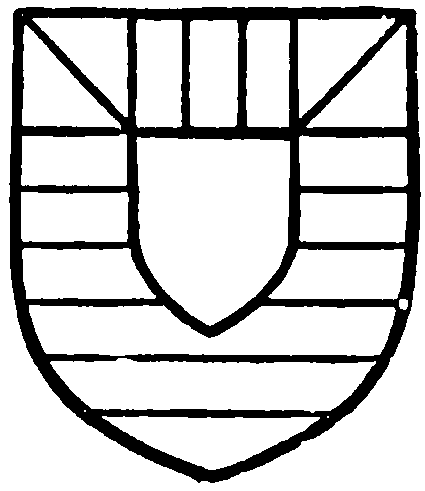
Mortimer. Barry or and azure a chief or with two pales between two gyrons azure therein and a scutcheon argent over all.
The virgate of land in ' Soresdene,' which Ralf had held of Waleran the Huntsman, had soon become merged in the 5-hide estate in Ann which Ilgeramus had held of Ralf de Mortimer, being in the possession of Thomas de Ann or de Cholderton towards the end of the 13th century. (fn. 114) It was from this land that Maud widow of Robert Waleran was demanding 17s. 9d. rent in dower in 1274. (fn. 115) Robert Waleran, son of William Waleran, was Sheriff of Gloucester, and possibly descended from the Huntsman. He died in 1272, leaving a minor as his heir. Maud, his second wife, was daughter of Ralph Russell of Dedham (co. Glouc.). (fn. 116) In 1277 the Sheriff of Hampshire was ordered to cause Joan, late the wife of Walter de Langford, tenant in chief, to have seisin of a third of 4 marks yearly of rent in Ann Savage, to hold for life as her dower of the said rent. (fn. 117) There is obviously some connexion between these two assignments of dower. The amounts are the same, 17s. 9d. being the precise equivalent of a third of 4 marks. Some light may, perhaps, be thrown on this connexion by the fact that Walter de Langford had granted his moiety of West Tytherley Manor to Robert Waleran for life in exchange for the manor of Little Winterbourne (co. Wilts.). (fn. 118)
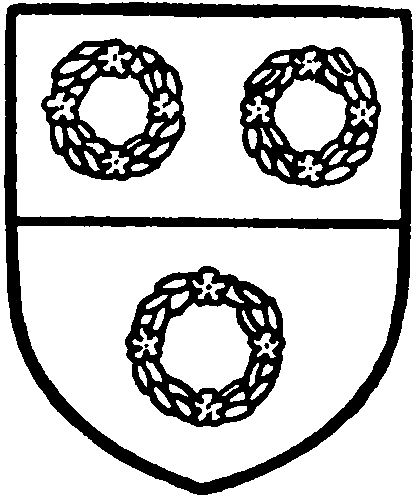
Duke. Party fessewise argent and azure with three wreaths counter-coloured.
There was a mill at Sarson worth 25s. in 1086, (fn. 119) and one is mentioned in a fine between John de Ann and Edward de Escote in 1324. (fn. 120) In 1489 Sir Richard Darell died seised of a water-mill there which he held of Sir Nicholas Lisle, his grandson John Awdley being named his heir. (fn. 121) Two mills are mentioned in a recovery of the manor in 1641. (fn. 122)
The priory of Ogbourne (co. Wilts.), which, as English representative of the abbey of Bee Hellouin, held the neighbouring manors of Monxton and Quarley (q.v.), owned a carucate of land in Amport and Over Wallop called GOLHORD or LA GOLDHORDE, which had formed part of Hugh de Port's holding in Ann in 1086. (fn. 123) This estate is first mentioned in 1226, in which year Richard and Edith, respectively son and widow of Henry de Stratfield, granted the reversion after their death to Henry, Abbot of Bee. (fn. 124) Some fifty years later Peter, Abbot of Bec, made a life grant to William de Wanetyng of a carucate and 2½ virgates of land in Amport and Monxton. (fn. 125)
From an Assize Roll of 1280 it appears that at one time the holder of Golhord owed suit at the hundred of Andover, but that Henry III, by a charter dated 1252–3, freed the Abbot of Bec and his successors of that and other obligations. (fn. 126) In 1331 Richard son of Richard de Golhord died seised of a messuage, 184½ acres of land and 4 acres of wood in Amport, together with 13s. 4d. rent in Wallop, leaving a son John, (fn. 127) of whom the king took fealty for the premises, as being held of the heir of John St. John, a minor, by the service of the sixteenth part of a knight's fee and suit of court every three weeks at the hundred of Andover. (fn. 128) Upon this, however, came Brother Richard de Beausevall, attorney-general in England for the Abbot of Bec, and asserted in Chancery that the abbot held the tenements by virtue of a fine levied in 1226 between Henry, then abbot, and Richard son of Henry de Stratfield, and by quitclaim from Richard son of Richard. The disputed premises were then resumed into the king's hands, and John de Golhord was summoned to make good his claim in Chancery. Since he did not appear, and Brother Richard produced both fine and deed of quitclaim, the escheator was ordered to deliver the lands and all issues received therefrom to the abbot or his attorney. (fn. 129) In 1346 the Prior of Ogbourne is bracketed with Joan Carew as holding 2 hides in Amport and Golhord. (fn. 130) This holding was doubtless included in the grant of Ogbourne property to John of Lancaster in 1404, and its subsequent separate history cannot be traced, though the name is preserved in Gollard Copse and Gollard Farm.

Plan of Amport Church
Church
The church of ST. MARY consists of a chancel 32 ft. 7 in. by 18 ft., with a north vestry and organ chamber, crossing under the central tower 13 ft. 9 in. square, north transept 12 ft 10 in. by 10 ft. 8 in., south transept 12 ft. 7 in. by 10 ft. and a nave 52 ft. 9 in. by 18 ft. 9 in., with a small porch at the north-west corner. All the measurements are taken within the walls.
The history of the building is confined to the 14th century and modern rebuilding. The chancel, tower and south transept are the only complete parts of the old church, and these date from about 1320–30. The main walls of the nave were of the same date, but little was left of these when the new north and south windows were put in in 1866, at which date the north transept was also rebuilt and the north porch and vestry were added. The organ chamber is a later addition still.
The 14th-century east window of the chancel has three trefoiled lights with additional smaller foils to the centre light, and the tracery above is composed of two trefoiled spandrels and a circle containing three flowing foils. The label outside is of scroll section returned at the springing.
The north window of the chancel and the easternmost one in the opposite wall are of the same date as the east window, having two trefoiled lights each, with a circle of three flowing foils over and a scrolled label. The second window in the south wall, also of the 14th century, has two lights with trefoiled ogee heads, and a foiled spherical triangle in the spandrel.
Beneath the first window of this wall is a piscina with octagonal basin, chamfered shelf, moulded jambs and moulded trefoiled ogee head with a plain roll label stopping on small crouching animals. The drain is in the form of a rose. To the west of this are the sedilia with projecting moulded jambs and divisions, and ogee heads enriched with foliage; the whole is original work, but much scraped down. The priest's doorway between the sedilia and the second window has plain chamfered jambs and twocentred arch without a label.
The vestry has a modern east doorway and a singlelight window on the north. The opening from the chancel has chamfered jambs and two-centred arch of two chamfered orders, all apparently of old stonework. The four arches supporting the tower, and the opening to the organ chamber, are similar, the latter being modern.
The north transept contains a two-light north window, which is a copy of the second window in the south wall of the chancel. In the east wall are two small pointed openings towards the organ chamber.
The south transept, used as the Marquess of Winchester's pew, has an east and a south window of 14th-century date, both similar to the second window on the south side of the chancel. In the west wall is a plain modern doorway.
The nave contains three windows on the north side and four on the south, all modern copies of those of the south transept. In the gable of the west wall is a large modern circular window with tracery.
The modern north doorway is placed near the west end, and has plain chamfered jambs and twocentred arch.
The tower has plain plastered walls with a projecting stone parapet at the top, below which is a hollow moulding enriched with four-leaf flowers and ball flowers. In each face just below this parapet is a small window of two trefoiled ogee-headed lights with a quatrefoil over.
Within the chancel rails are five marble slabs to the Paulet family, and a number of 17th-century slabs in the chancel floor, and on the south wall are tablets to Mary wife of Robert Swayne, 1635, and to her niece, Katherine Young, 1638. In the Paulet pew is a beautiful white marble tablet to the fifteenth Marquess of Winchester, killed at Magersfontein, 1899.
All the roofs are modern with plaster between the rafters. The east and west faces of the tower show the weathering of the original chancel and nave roofs, which were of slightly steeper pitch than the present ones.
All the furniture of the church is modern with the exception of a carved chair in the south transept, bearing the date 1688. There is a little 17th-century Flemish glass in the south window of this transept, and at the bottom of the lights the Paulet motto 'Aymez Loyaulte.'
The tower contains a ring of six bells, the treble being by Mears & Stainbank, 1895; the second is inscribed ' Clement Tosier cast me in the year of 1717,' and the names of the churchwardens. The third was also cast by the same founder in 1686. The fourth is by I D. 1703. The fifth and tenor are by William Purdue of Salisbury, 1662.
The plate consists of a silver chalice of 1798 and two patens, one undated, the other of 1878; also a plated chalice and paten given by Archdeacon Webber in 1830, and a plated and a pewter flagon.
The earliest book of registers contains baptisms from 1665 to 1722, marriages from the same date to 1754, and burials also from the same date to 1681. Next to these are entries of burials on loose paper sheets from 1680 to 1760. The third book continues the baptisms and burials up to 1812, and the fourth book contains marriages from 1754 to 1812.
Consent was given by the bishop in 1744 for burials of this parish to take place at the chapelry of Appleshaw.
Advowsons
Richard le Poor, Bishop of Chichester (1215–17), acquired the church of Amport, (fn. 131) no doubt from Adam de Port, in whose gift it was, in 1209, (fn. 132) and appropriated it to the dean and chapter. The Dea and Chapter of Chichester have continuously presented the vicars from that date. (fn. 133) In 1291 the church with chapel and pension was valued at £26 13s. 4d., but the vicarage was not assessed, as the vicar received all and paid a pension of £40 (sic) to the patrons. (fn. 134)
There was a chapel in Cholderton at least as early as the 12th century, and in 1200 Henry de Ann lord of the manor, acknowledged it to pertain to the church of Amport, and consequently to be in the gift of Adam de Port. (fn. 135) A few years later, however Henry de Columbars was claiming the right of presentation against Adam de Port, on the plea that the chapel was founded on his fee. Both disputants alleged that their ancestors had presented, but the verdict has not been preserved. (fn. 136) The result, however, is of little consequence, as within a very short time of this date the advowson had been acquired by Chichester Cathedral (vide ante).
There is a Primitive Methodist chapel in Amport built in 1846.
The school was built and endowed in 1815 from the Sheppard charity. It was enlarged in 1892, and again in 1898, and will now accommodate 190 children.
Charities
The School and Almshouses Charity was founded by the will of the Rev. Thomas Sheppard, D.D., dated 30 June 1812, and proved in the Prerogative Court of Canterbury in 1814, and augmented by his widow, Sophia Sheppard, by deed of 25 July 1844. The trust estate consists of (1) the land and buildings used as a schoolhouse; (2) £9,000 consols standing in the corporate name of the president and scholars of Magdalen College, Oxford; (3) £1,208 6s. 8d. like stock standing in the like name, being the gift of Mrs. Sophia Sheppard. By an order of the Charity Commissioners of 23 February 1904, made under the Board of Education Act, 1899, it was determined that the part of the endowment which constituted' Sheppard's Educational Foundation' consisted of the schoolhouse, £3,000 consols, part of the £9,000 like stock, and £136 2s. 3d. consols, part of the £1,208 6s. 8d. like stock.
Under the trusts the income of £6,000 consols, being £150 a year, is applicable in the maintenance of six poor widows upwards of fifty years of age, residing in six almshouses erected by Mrs. Sophia Sheppard, and out of the income of £1,208 6s. 8d. consols £20 per annum is payable to the rector of Quarley for fuel and comforts for the poor of that parish.